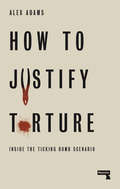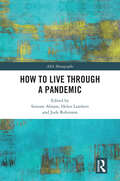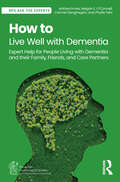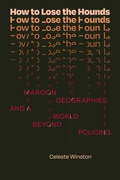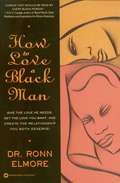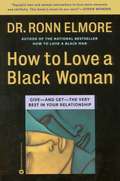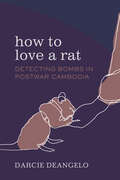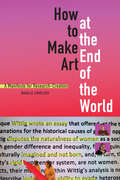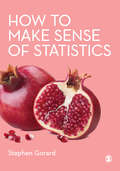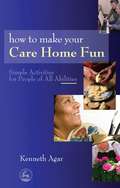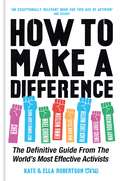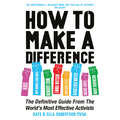- Table View
- List View
How to Interpret Literature: Critical Theory for Literary and Cultural Studies
by Robert Dale ParkerOffering a refreshing combination of accessibility and intellectual rigor, How to Interpret Literature: Critical Theory for Literary and Cultural Studies, Second Edition, presents an up-to-date, concise, and wide-ranging historicist survey of contemporary thinking in critical theory. <p><p> The only book of its kind that thoroughly merges literary studies with cultural studies, this text provides a critical look at the major movements in literary studies since the 1930s, including those often omitted from other texts. It is also the only up-to-date survey of literary theory that devotes extensive treatment to Queer Theory and Postcolonial and Race Studies. How to Interpret Literature, Second Edition, is ideal as either a stand-alone text or in conjunction with an anthology of primary readings such as Robert Dale Parker's Critical Theory: A Reader for Literary and Cultural Studies.
How to Justify Torture: Inside the Ticking Bomb Scenario
by Alex AdamsFrom Batman Begins to Tom Clancy, How to Justify Torture shows how contemporary culture creates simplified narratives about good guy torturers and bad guy victims, how dangerous this is politically, and what we can do to challenge it.If there was a bomb hidden somewhere in a major city, and you had the person responsible in your custody, would you torture them to get the information needed to stop the bomb exploding, preventing a devastating terrorist attack and saving thousands of lives?This is the ticking bomb scenario -- a thought experiment designed to demonstrate that torture can be justified.In How to Justify Torture, cultural critic Alex Adams examines the ticking bomb scenario in-depth, looking at the ways it is presented in films, novels, and TV shows -- from Batman Begins and Dirty Harry to French military thrillers and home invasion narratives. By critiquing its argument step by step, this short, provocative book reminds us that, despite what the ticking bomb scenario will have us believe, torture can never be justified.
How to Keep an Open Mind: An Ancient Guide to Thinking Like a Skeptic (Ancient Wisdom for Modern Readers)
by Sextus EmpiricusHow ancient skepticism can help you attain tranquility by learning to suspend judgmentAlong with Stoicism and Epicureanism, Skepticism is one of the three major schools of ancient Greek philosophy that claim to offer a way of living as well as thinking. How to Keep an Open Mind provides an unmatched introduction to skepticism by presenting a fresh, modern translation of key passages from the writings of Sextus Empiricus, the only Greek skeptic whose works have survived.While content in daily life to go along with things as they appear to be, Sextus advocated—and provided a set of techniques to achieve—a radical suspension of judgment about the way things really are, believing that such nonjudging can be useful for challenging the unfounded dogmatism of others and may help one achieve a state of calm and tranquility. In an introduction, Richard Bett makes the case that the most important lesson we can draw from Sextus’s brand of skepticism today may be an ability to see what can be said on the other side of any issue, leading to a greater open-mindedness.Complete with the original Greek on facing pages, How to Keep an Open Mind offers a compelling antidote to the closed-minded dogmatism of today’s polarized world.
How to Kill a Vampire: Fangs in Folklore, Film and Fiction
by Liisa LadouceurA fascinating investigation of what strikes fear in an immortal’s heartVampires exist. And in every culture with a legend about bloodsuckers that rise from the grave to prey upon the living, there are rules and rituals for how to destroy them. How to Kill a Vampire is the first book to focus specifically on all known ways to prevent vampirism, protect oneself against attacks, and ultimately how to destroy the undead, as documented in folklore as well as horror film, TV, and books.Covering everything from obscure legends to contemporary blockbusters, Ladouceur’s unique approach to vampires traces the evolution of how to kill the fictional creatures and celebrates the most important slayers.In exploring how and why we create these monsters and the increasingly complex ways in which we destroy them, the book not only serves as a handy guide to the history and modern role of the vampire, it reveals much about the changing nature of human fears.
How to Know Everything: Ask better questions, get better answers
by Elke WissThe international bestseller that will sharpen your mind, broaden your perspective and transform your relationships._____________________________________________________WHY ARE WE SO BAD AT ASKING GOOD QUESTIONS?In an increasingly polarized world, asking better questions in our daily and working lives is a radical shortcut to personal and professional success. It can create space for us to rethink our positions, find answers together, and even change our minds for the better.Drawing on the lessons of Socrates and other great thinkers, practical philosopher Elke Wiss lays out an essential toolkit to help you:· Transform debates into dialogues · Embrace your doubts like a true philosopher· Ditch your ego and become an active listener· Discover an open and curious Socratic attitude· Learn Sherlock Holmes's powers of observation · Open conversations up or dig down deeper with key question types· Explore thorny issues and avoid classic question pitfalls· Face your fear of asking and start connectingThe right questions can unlock the answers to anything - and help you know everything, without being a know-it-all. _____________________________WHAT READERS ARE SAYING:'Read this book, it will enrich your life!''A disarming and urgent book in today's world!''A great book for anyone who wants to better understand themselves and others!''Everyone should read this. What fascinating conversations we would have then!''A clear and practical book for brave thinkers who want to start having better, deeper conversations.''I found this book so valuable! A real enrichment to my daily life.' 'What a gem this book is!''Highly recommended for anyone who usually gets bogged down in discussions, quarrels, disagreements that lead to nothing.''A ray of hope in a time of dispute and polarization.' 'Elke Wiss makes practical philosophy manageable for everyone. A must read!''A cheerful, unconventional book.' 'An inspiring, easy-to-read book, full of practical exercises to get yourself started right away. For me it's a must read!''Its powerful message urges us to connect more with each other and with ourselves.''Some books can actually change your worldview or your daily actions, and as far as I'm concerned this is one of them. I recommend it to everyone.'
How to Live Forever: The Enduring Power of Connecting the Generations
by Marc FreedmanThe secret to happiness, longevity, and living on is through mentoring the next generationIn How to Live Forever, Encore.org founder and CEO Marc Freedman tells the story of his thirty-year quest to answer some of contemporary life's most urgent questions: With so many living so much longer, what is the meaning of the increasing years beyond 50? How can a society with more older people than younger ones thrive? How do we find happiness when we know life is long and time is short? In a poignant book that defies categorization, Freedman finds insights by exploring purpose and generativity, digging into the drive for longevity and the perils of age segregation, and talking to social innovators across the globe bringing the generations together for mutual benefit. He finds wisdom in stories from young and old, featuring ordinary people and icons like jazz great Clark Terry and basketball legend Kareem Abdul-Jabbar. But the answers also come from stories of Freedman's own mentors-a sawmill worker turned surrogate grandparent, a university administrator who served as Einstein's driver, a cabinet secretary who won the Presidential Medal of Freedom, and the gym teacher who was Freedman's father.How to Live Forever is a deeply personal call to find fulfillment and happiness in our longer lives by connecting with the next generation and forging a legacy of love that lives beyond us.
How to Live Japanese
by Yutaka YazawaA fascinating exploration of all things Japan, including the country’s history, culture, customs, and cuisine.Whether it’s perfecting the art of forest-bathing—shinrin-yoku—or celebrating imperfections in kintsugi, Japanesse customs have been thriving for centuries alongside modern practices of well-being.In How to Live Japanese, Yutaka Yazawa provides the ultimate insider’s guide to the country, full of inspiration and insight to help you experience the very best of Japanese design, cookery, philosophy, and culture. Not only is Tokyo the mother of all metropolises, making it a guiding light for how we can live together amicably in an ever-urbanizing world, but also, with two thirds of the country covered in forest, there is still much respect and celebration of the natural world.From Miyazaki to mountains, sake to sparking joy, find your Zen, discover the joy of ikigai and make time to learn about the land of the rising sun. You’ll be all the better for some time spent with How to Live Japanese.
How to Live Through a Pandemic (ASA Monographs)
by Simone Abram, Helen Lambert and Jude RobinsonThis book explores what anthropology can contribute to an understanding of how people live through pandemics. It reflects on how pandemics are experienced and what we can learn from Covid-19 as well as previous instances that might inform future responses and help to alleviate suffering. The chapters highlight current research and longer-term reflections from different countries and areas of the discipline, covering medical anthropology, care and surveillance, digital and experimental ethnography, and the everyday economies of lockdown. They show the breadth and originality of anthropological work relevant to thinking about and responding to pandemic situations. Extending beyond Covid-19, the volume considers the implications for ongoing and future research under pandemic restrictions and gives a broad overview of current anthropology relevant to questions about pandemics. It will be of interest to both academic and applied anthropologists, as well as to sociologists and those working in global and public health.
How to Live Well with Dementia: Expert Help for People Living with Dementia and their Family, Friends, and Care Partners (BPS Ask The Experts in Psychology Series)
by Anthea Innes Megan E. O’Connell Carmel Geoghegan Phyllis FehrHow to Live Well with Dementia: Expert Help for People Living with Dementia and their Family, Friends, and Care Partners provides an array of essential guidance about the different aspects of dementia for all whose lives are touched by dementia, including people living with dementia and their support network.Following an effective Q&A framework, this book offers valuable, easy-to-navigate guidance on the burning questions that those living with a dementia diagnosis and their carer/supporter need to know. Questions addressed include ‘How can I adjust to life with the diagnosis?’, ‘How can I plan for the future?’, and ‘How can we support our loved ones living with dementia?’. It provides expert explanations about changes in the brain and the various causes and types of dementia, as well as support on how to adjust to living with a diagnosis. It also offers practical information about care planning and advanced directives, maintaining health and social connections, accessing appropriate community care, and supporting medical and hospital care. It concludes with important self-care information for care/support partners.Written jointly by academic experts and experts through lived experience, this book is indispensable for people living with dementia, care partners, and anyone wanting to understand more about the condition, as well as health and social care professionals and students of health and social care.
How to Live When You Could Be Dead
by Deborah James"Deborah James has captured the heart of the nation." —The Duke and Duchess of Cambridge @KensingtonRoyal"Brave, bright, beautiful." —Lorraine Kelly"Deborah's ability to find positivity in the darkest of places is an inspiration to us all." —Davina McCall"I was alive when I should have been dead. In another movie, I missed the sliding door and departed this wondrous life long ago. Like so many others, I had to learn to live not knowing if I have a tomorrow, because, statistically, I didn't. At the age of 35, I was blindsided by incurable bowel cancer—I was given less than an 8 percent chance of surviving five years. Five years later, my only option was to live in the now and to value one day at a time."How do you turn your mind from a negative spiral into realistic and rebellious hope? How do you stop focusing on the why and realize that "why not me" is just as valid a question?When Deborah James was diagnosed with incurable bowel cancer at just 35, she learned a powerful lesson: the way we respond to any given situation empowers or destroys us. And with the right skills and approach, we can all face huge challenges and find strength and hope in the darkest of places.How to Live When You Could Be Dead, a Sunday Times bestseller, will show you how. It will awaken you to question your life as if you didn't have a tomorrow and live it in the way you want to today. By harnessing the power of positivity and valuing each day as though it could be your last, you'll find out, as Deborah did, that it is possible to live with joy and purpose, no matter what.
How to Live and Work in the UK
by Mathew Collins Nicky BarclayThis essential handbook is for anyone wishing to enter the UK to work, study, settle, join their family, or visit - and who wants to remain in the UK indefinitely. It is ideal for students, would-be immigrants to the UK, HR professionals, and expats. It will help them to identify which visa category is applicable to them, and will prepare them for passing the Life in the UK test as set by the Home Office for those applying for British citizenship. Written by immigration practitioners, this book is an easy to use handbook that readers will refer to, time and time again. This book is an essential read for those planning to come to the UK and who need to make a visa application. It covers: - critical information on which visa categories may be appropriate to their circumstances - how to make a visa application - what to expect when they arrive in the UK, including important information on how to establish a National Insurance number (for working), familiarising themselves with the taxation system, how to register with a Doctor and Dentist, plus much more. For those employing non-UK/EU citizens, this book explains: - what essential checks you must put in place - details of the Points Based System and how individuals can qualify - how to obtain a licence to employ foreign nationals and the HR compliance issues that need to be in place in order to remain compliant with the UK Border Agency For employers dealing with intra-company transfers and global people mobility issues, it offers a simple and understandable way to assess employees and whether they meet the appropriate visa requirements.
How to Live and Work in the UK: The Essential Guide To Uk Immigration, The Points Based System And Life In The Uk
by Mathew Collins Nicky BarclayThis essential handbook is for anyone wishing to enter the UK to work, study, settle, join their family, or visit - and who wants to remain in the UK indefinitely. It is ideal for students, would-be immigrants to the UK, HR professionals, and expats. It will help them to identify which visa category is applicable to them, and will prepare them for passing the Life in the UK test as set by the Home Office for those applying for British citizenship. Written by immigration practitioners, this book is an easy to use handbook that readers will refer to, time and time again. This book is an essential read for those planning to come to the UK and who need to make a visa application. It covers: - critical information on which visa categories may be appropriate to their circumstances - how to make a visa application - what to expect when they arrive in the UK, including important information on how to establish a National Insurance number (for working), familiarising themselves with the taxation system, how to register with a Doctor and Dentist, plus much more. For those employing non-UK/EU citizens, this book explains: - what essential checks you must put in place - details of the Points Based System and how individuals can qualify - how to obtain a licence to employ foreign nationals and the HR compliance issues that need to be in place in order to remain compliant with the UK Border Agency For employers dealing with intra-company transfers and global people mobility issues, it offers a simple and understandable way to assess employees and whether they meet the appropriate visa requirements.
How to Lose the Hounds: Maroon Geographies and a World beyond Policing (Errantries)
by Celeste WinstonIn How to Lose the Hounds Celeste Winston explores marronage—the practice of flight from and placemaking beyond slavery—as a guide to police abolition. She examines historically Black maroon communities in the Maryland suburbs of Washington, DC, that have been subjected to violent excesses of police power from slavery until the present day. Tracing the long and ongoing historical geography of Black freedom struggles in the face of anti-Black police violence in these communities, Winston shows how marronage provides critical lessons for reimagining public safety and community well-being. These freedom struggles take place in what Winston calls maroon geographies—sites of flight from slavery and the spaces of freedom produced in multigenerational Black communities. Maroon geographies constitute part of a Black placemaking tradition that asserts life-affirming forms of community. Winston contends that maroon geographies operate as a central method of Black flight, holding ground, and constructing places of freedom in ways that imagine and plan a world beyond policing.
How to Love Animals: In a Human-Shaped World
by Henry ManceA personal journey into our evolving relationships with animals, and a thought-provoking look at how those bonds are being challenged and reformed across disciplinesWe love animals, but does that make the animals' lives any happier? With factory farms, climate change and deforestation, this might be the worst time in history to be an animal. If we took animals' experiences seriously, how could we eat, think and live differently?How to Love Animals is a lively and important portrait of our evolving relationship with animals, and how we can share our planet fairly. Mance works in an abattoir and on a pig farm to explore the reality of eating meat and dairy. He explores our dilemmas over hunting wild animals, over-fishing the seas, visiting zoos and saving wild spaces. What might happen if we extended the love we show to our pets to other sentient beings? In an age of extinction and pandemics, our relationship with animals has become unsustainable. Mance argues that there has never been a better time to become vegetarian or vegan, and that the conservation movement can flourish, if people in wealthy countries shrink our footprint.Mance seeks answers from chefs, farmers, activists, philosophers, politicians and tech visionaries who are redefining how we think about animals. Inspired by the author's young daughters, his book is a story of discovery and hope that outlines how we can find a balance with animals that fits with our basic love for them.
How to Love a Black Man
by Ronn ElmoreAs he sheds light on the hidden emotional psychological recesses of the black man's inner world, Dr. Elmore provides down-to-earth advice and real-life anecdotes drawn from his seminars and radio call-in shows to show women how to create the fulfilling relationship each partner wants and deserves.
How to Love a Black Woman: Give-and Get-the Very Best in Your Relationship
by Dr Ronn ElmoreBlack women treasure trust and consistency in love. They also desire a sense of security rooted in something more--and much more precious--than just material concerns. Now Dr. Ronn Elmore, noted psychotherapist and author of the bestselling How to Love a Black Man, draws from his years of experience to reveal the power men have to respond to the most profound desires of the Black women they love. Straightfoward, insightful, filled with dozens of practical life-transforming "Policies and Procedures" and relevant, real-life examples, How to Love a Black Woman shows you how to build a rich, mutually satisfying, rewarding relationship as you:7 Discover the very different communication and conflict-resolution styles women and men use 7 Accept her for who she is rather than who she "could" be 7 Share your insides with her-the good, the bad, and the ugly 7 Support her in ways that respect her personal strengths.
How to Love a Rat: Detecting Bombs in Postwar Cambodia (Atelier: Ethnographic Inquiry in the Twenty-First Century #17)
by Darcie DeAngeloHow to Love a Rat takes place in a Cambodian minefield. Working amid hidden bombs, former war combatants use explosive-sniffing rats to clear mines from the land. In total, an estimated four to six million landmines in Cambodia have been left behind by wars that ended decades ago. This has created the conditions for a flourishing mine-clearance industry, where workers who were once enemy combatants may now be employed on the same clearance teams. Zeroing in on two distinct sets of feelings, Darcie DeAngelo paints a portrait of the love experienced between humans and rats and the suspicions felt between former adversaries turned coworkers. In doing so, she points to how human-animal relationships in the minefield produce models for relationality among people from opposing sides of war. The ways the deminers love the rats mediate both the traumatic violence of the past and the uncertain dangers of the minefield. The book's stories depict an transformative postwar ecology emerging through human-nonhuman relationships, including those shared between humans and rats, landmines, and spirits.
How to Make Art at the End of the World: A Manifesto for Research-Creation
by Natalie LovelessIn recent years, the rise of research-creation—a scholarly activity that considers art practices as research methods in their own right—has emerged from the organic convergences of the arts and interdisciplinary humanities, and it has been fostered by universities wishing to enhance their public profiles. In How to Make Art at the End of the World Natalie Loveless draws on diverse perspectives—from feminist science studies to psychoanalytic theory, as well as her own experience advising undergraduate and graduate students—to argue for research-creation as both a means to produce innovative scholarship and a way to transform pedagogy and research within the contemporary neoliberal university. Championing experimental, artistically driven methods of teaching, researching, and publication, research-creation works to render daily life in the academy more pedagogically, politically, and affectively sustainable, as well as more responsive to issues of social and ecological justice.
How to Make Herself Agreeable to Everyone: 'A book of real power' ? STYLIST, Best Non-Fiction Books of 2024
by Cameron RussellThe realities of the fashion industry exposed in this devastating account of the life of a successful supermodel. 'A unique and honest perspective on the fashion industry... Cameron doesn&’t just hold the door open for more voices from within fashion, she makes a compelling argument as to why they must be heard.' CHRISTY TURLINGTON BURNS Scouted by a modelling agent when she was sixteen years old, Cameron Russell approached her job with scepticism. She was a precocious and serious student with her sights set on college — not the runway. But modelling seemed to offer young women like her access to wealth, fame, and influence. Besides, as she was often reminded, there were 'a million girls in line' to replace her. A ferocious, visceral memoir, How to Make Herself Agreeable to Everyone chronicles how Russell learned to navigate the dizzying space between physical appearance and interiority, and making money in an often-exploitative system. *** 'A book of real power.' STYLIST, Best Non-Fiction Books of 2024 'Russell&’s voice is steady and compelling throughout, offering young women, especially, a thoughtful and powerful way through.' PEGGY ORENSTEIN, author of Girls & Sex 'Compelling, smart and insightful.' VENETIA LA MANNA, host of All The Small Things 'Unforgettable... Fiercely intellectual, deeply vulnerable, and unapologetically honest, Russell reads through the layers of gender, race, capital, and exploitation in the fashion industry.' IMANI PERRY, author of South to America
How to Make Herself Agreeable to Everyone: A Memoir
by Cameron RussellA bold and innovative memoir that explores who holds the power in an image-obsessed culture, from the model and activist who helped organize the movement to bring equity to fashion. &“Fiercely intellectual, deeply vulnerable, and unapologetically honest.&”—Imani Perry, National Book Award–winning author of South to America &“By elevating me for something I have no control over, the industry and economy signal to all women: there is almost nothing you can do or create that is as valuable as how you look.&” Scouted by a modeling agent when she was just sixteen years old, Cameron Russell first approached her job with some reservations: She was a serious student with her sights set on college, not the runway. But modeling was a job that seemed to offer young women like herself unprecedented access to wealth, fame, and influence. Besides, as she was often reminded, &“there are a million girls in line&” who would eagerly replace her. In her fierce and innovative memoir, Russell chronicles how she learned to navigate the dizzying space between physical appearance and interiority and making money in an often-exploitative system. Being &“agreeable,&” she found, led to more success: more bookings and more opportunities to work with the world&’s top photographers and biggest brands. But as her prominence grew, Russell found that achievement under these conditions was deeply isolating and ultimately unsatisfying. Instead of freedom, she was often required to perform the role of compliant femme fatale, so she began organizing with her peers, helping to coordinate movements for labor rights, climate and racial justice, and bringing MeToo to the fashion industry. Intimate and illuminating, How to Make Herself Agreeable to Everyone is a nuanced, deeply felt memoir about beauty, complicity, and the fight for a better world.
How to Make Sense of Statistics
by Stephen GorardIn a new textbook designed for students new to statistics and social data, Stephen Gorard focuses on non-inferential statistics as a basis to ensure students have basic statistical literacy. Understanding why we have to learn statistics and seeing the links between the numbers and real life is a crucial starting point. Using engaging, friendly, approachable language this book will demystify numbers from the outset, explaining exactly how they can be used as tools to understand the relationships between variables. This text assumes no previous mathematical or statistical knowledge, taking the reader through each basic technique with step-by-step advice, worked examples, and exercises. Using non-inferential techniques, students learn the foundations that underpin all statistical analysis and will learn from the ground up how to produce theoretically and empirically informed statistical results.
How to Make Sense of Statistics
by Stephen GorardIn a new textbook designed for students new to statistics and social data, Stephen Gorard focuses on non-inferential statistics as a basis to ensure students have basic statistical literacy. Understanding why we have to learn statistics and seeing the links between the numbers and real life is a crucial starting point. Using engaging, friendly, approachable language this book will demystify numbers from the outset, explaining exactly how they can be used as tools to understand the relationships between variables. This text assumes no previous mathematical or statistical knowledge, taking the reader through each basic technique with step-by-step advice, worked examples, and exercises. Using non-inferential techniques, students learn the foundations that underpin all statistical analysis and will learn from the ground up how to produce theoretically and empirically informed statistical results.
How to Make Your Care Home Fun: Simple Activities for People of All Abilities
by Sue RolfeAs we grow older, our need to be engaged in interesting activities does not diminish and is vital to our quality of life. How to Make Your Care Home Fun examines the need for activities for elderly people in care and offers a practical programme of entertaining activities that can be used in nursing and residential homes, day centres, rehabilitation centres and hospices. As well as suggesting a programme of activities for older people in care homes including arts and crafts, role-playing, gardening and cooking, it also takes the stance that 'activity nursing' should be integral to all personal care plans and not simply regarded as an add on to medical care. The author also examines how care homes are run and regulated in the light of recent legislation and considers the services provided by care homes and areas of potential deficiency. The book offers a wide selection of activities that can be used with people of all abilities and have greatly improved quality of life for elderly people in care. Highlighting the value of nursing that caters for an individual's physical, mental and emotional needs, this book is an ideal resource for care home professionals and anyone who is responsible for the well-being of elderly people in care.
How to Make a Difference: The Definitive Guide from the World's Most Effective Activists
by Kate Robertson Ella Robertson"An exceptionally relevant book for this age of activism." Bob GeldofWith a foreword by Kofi Annan, former Secretary-General of the UN (1997-2006).How to Make a Difference is a practical roadmap to modern day activism created by the powerful and imaginative minds behind the world's biggest campaigns including Colin Kaepernick, Emma Watson, Sir Bob Geldof, Fatima Bhutto, Black Lives Matter, Doutzen Kroes, Yeonmi Park, Terry Crews, Cher, Matt Damon, Paul Polman and Gina Miller; collectively they combine the latest models of thinking, their real life experiences, radical techniques and effective advice in order to help incentivize everyone and anyone who has ever wondered, how can I help? From How to Change the Law, How to Protest, How to Use Social Media Effectively, How to End a Problem Forever and How to Change a Big Organization, this book educates as much as it encourages and informs us all to see the world as something that can and must be changed. This book will help you find an active role in positive, necessary activism and meaningful change on every scale across the globe. The only book to pool together the biggest names in activism and showcase how they have used their voices, their networks and their abilities to change the world around us.How to Make a Difference speaks to a generation who are switching selfie-sticks for protest placards and will showcase how everyone has the ability to be the change they want to see in the world.If not now, when? If not you, who?Perfect for fans of This Is Not a Drill, No One Is Too Small to Make a Difference and There Is No Planet B.
How to Make a Difference: The Definitive Guide from the World's Most Effective Activists
by Kate Robertson Ella Robertson"An exceptionally relevant book for this age of activism." Bob GeldofWith a foreword by Kofi Annan, former Secretary-General of the UN (1997-2006).How to Make a Difference is a practical roadmap to modern day activism created by the powerful and imaginative minds behind the world's biggest campaigns including Colin Kaepernick, Emma Watson, Sir Bob Geldof, Fatima Bhutto, Black Lives Matter, Doutzen Kroes, Yeonmi Park, Terry Crews, Cher, Matt Damon, Paul Polman and Gina Miller; collectively they combine the latest models of thinking, their real life experiences, radical techniques and effective advice in order to help incentivize everyone and anyone who has ever wondered, how can I help? From How to Change the Law, How to Protest, How to Use Social Media Effectively, How to End a Problem Forever and How to Change a Big Organization, this book educates as much as it encourages and informs us all to see the world as something that can and must be changed. This book will help you find an active role in positive, necessary activism and meaningful change on every scale across the globe. The only book to pool together the biggest names in activism and showcase how they have used their voices, their networks and their abilities to change the world around us.How to Make a Difference speaks to a generation who are switching selfie-sticks for protest placards and will showcase how everyone has the ability to be the change they want to see in the world.If not now, when? If not you, who?Perfect for fans of This Is Not a Drill, No One Is Too Small to Make a Difference and There Is No Planet B.(p) 2019 Octopus Publishing Group

